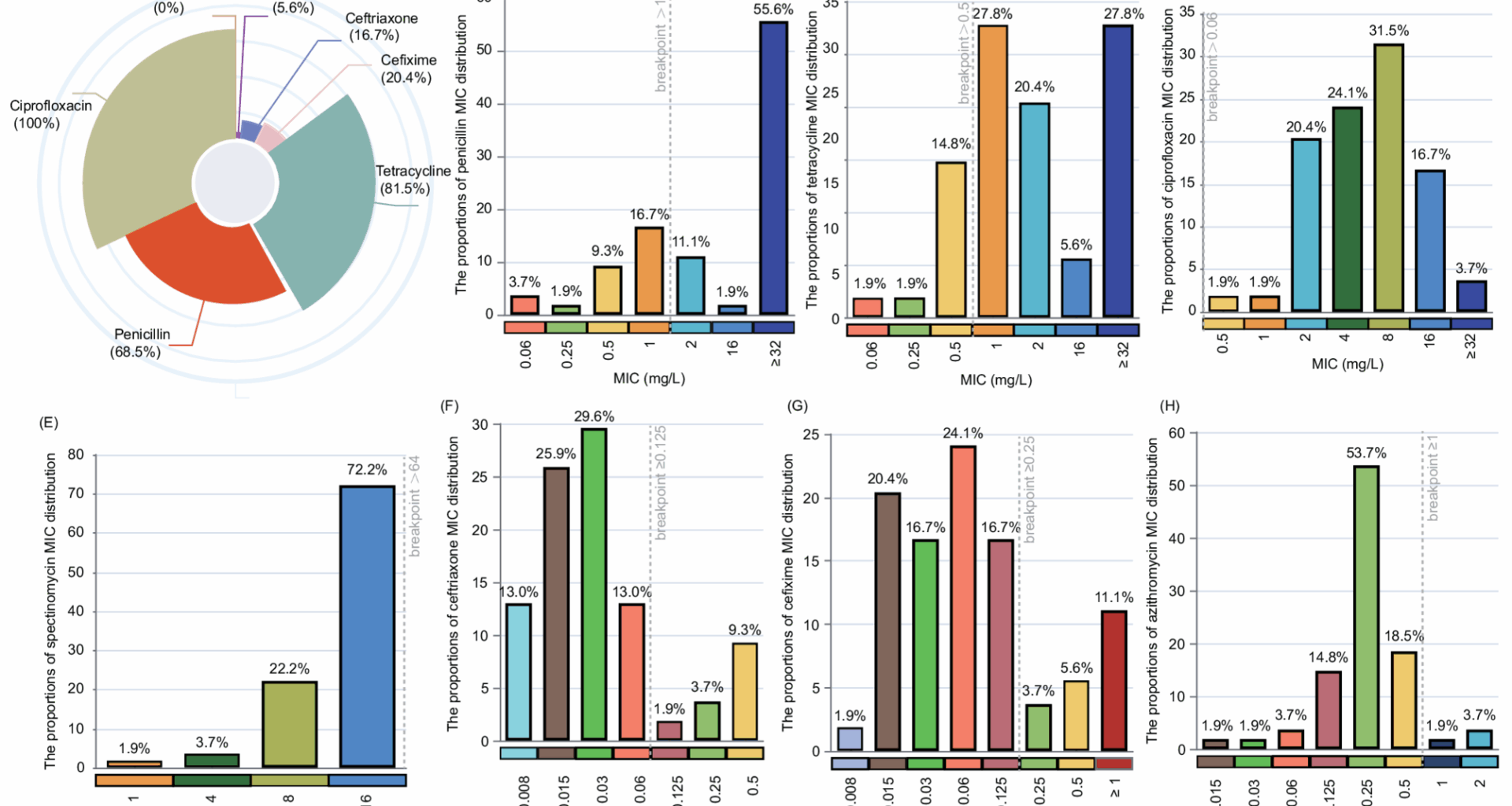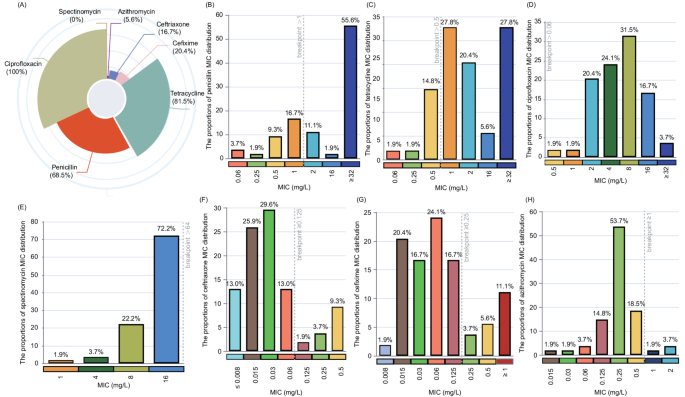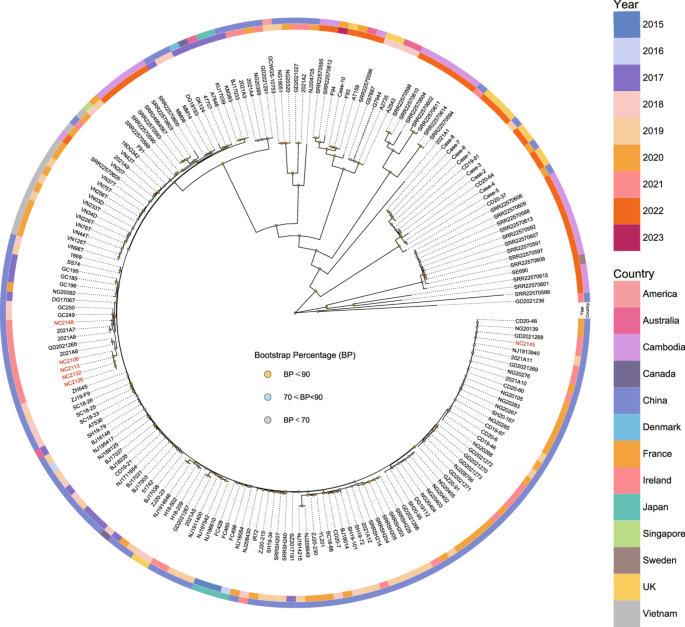New infections and AMR trends of N. gonorrhoeae in Nanchang, China
As demonstrated in Supplemental Fig. 1, the incidence of reported gonorrhea cases in China remained relatively stable from 2010 to 2020, with a significant peak of 138,855 cases recorded in 2017, followed by a slight decline. In the same year, Jiangxi Province reported 4,628 infections, representing 3.33% of the national total, which was consistent with the national incidence rate. Nanchang is the sole sentinel city in Jiangxi, China, that has been incorporated into the China-GASP. To further assess the trends in AMR of gonorrhea in Nanchang in 2021 and then inform clinical treatment strategies, we collected 54 clinical strains of N. gonorrhoeae for antibiotic susceptibility testing.
The results indicated resistance rates of 68.5%, 81.5%, and 100% for penicillin, tetracycline, and ciprofloxacin, respectively (Fig. 1A), with the highest resistance distribution ratios at median levels of MIC ≥ 32, ≥32, and 8 mg/L (Figs. 1B–D). Although no isolates exhibited resistance to spectinomycin (Fig. 1A), moderate susceptibility was observed, with MICs of 16 mg/L in 72.2% of cases (Fig. 1E). Subsequent analyses indicated decreased susceptibility rates for ceftriaxone, with a MIC of ≥ 0.125 mg/L observed in 16.7% of cases, and for cefixime, with an MIC of ≥ 0.25 mg/L in 20.4% of cases (Fig. 1A). The proportions of strains resistant to ceftriaxone and cefixime, with MICs >0.125 mg/L, were 13% and 20.4%, respectively (Figs. 1F-G). In contrast, resistance to azithromycin was detected in only 5.6% of the samples (Fig. 1A). Notably, strains with an MIC of 0.25 mg/L represented the largest proportion, accounting for 53.7% (Fig. 1H). In summary, N. gonorrhoeae was identified as a high-priority pathogen in Nanchang, China in 2021 due to the high-level AMR rates.
The AMR trends of clinical N. gonorrhoeae from Nanchang City in 2021. (A) the percentage of gonococcal isolates exhibiting resistance to penicillin, tetracycline, ciprofloxacin, spectinomycin, and azithromycin, as well as decreased susceptibility to ceftriaxone and cefixime. (B–H) The proportion of N. gonorrhoeae isolates with varying MICs for penicillin, tetracycline, ciprofloxacin, spectinomycin, ceftriaxone, cefixime and azithromycin(n = 54 isolates)
Genotyping and AMR gene analysis of the ESCs decreased-susceptible N. gonorrhoeae
WGS was conducted to analyze the molecular characteristics of twelve strains with decreased susceptibility to ESCs, among which three strains also exhibited resistance to azithromycin (Supplemental Table 3). Subsequently, assembled scaffolds were subjected to genotyping, and the results in Table 1 revealed that the NG-MAST could be categorized into four known sequence types (STs), accounting for 33.33% of the strains, along with eight unidentified genotypes. The primary distinction for the undetected genotypes was attributed to single-nucleotide polymorphisms in the porB and tbpB genes. Regarding the MLST, seven STs were identified, all of which had been previously documented. Notably, the MLST-7365 cluster, comprising five isolates, was identified as the predominant cluster, with three out of the five strains exhibiting resistance to azithromycin. The MLST-8123 was identified in two isolates, while MLST-1903, 1580, 7367, 8126, and 15278 were each found in a single isolate. To elucidate the relationship between resistance genes and antibiotic phenotypes, mutations in seven resistance genes were investigated using NG-STAR data. Nine isolates were classified into six STs, with ST-3903 identified as the predominant allele. Furthermore, two strains, designated NC2111 and NC2130, exhibited penA alleles that have not been previously documented, and the NG-STAR genotype of NC2152 represents a novel classification.
Table 1 Genotyping and AMR gene analysis of ESCs decreased-susceptible strains
The analysis of AMR genes revealed that six strains demonstrating high-level resistance to ESCs harbored the penA allele-1548, characterized by the type LX penA-60.001 gene mutations, including D345A, F504L, N512Y, and G545S. Additionally, six clones related to penA−60.001 allele exhibited mutations in genes such as ponA (L421P), gyrA (S91F, D95A), parC (S87R), and a deletion at the − 35 A position in mtrR. Furthermore, five strains with high MICs for penicillin were identified with the TEM β-lactamase variants TEM-135 and TEM-1; among these, two strains, designated as NC2145 and NC2148, also exhibited penA-60.001 mosaic mutations. All strains resistant to ESCs possessed a wild-type 23 S rRNA gene, which was associated with azithromycin sensitivity and low-level resistance phenotypes.
Further analysis revealed that the six penA−60.001 isolates could be stratified into three distinct profiles based on their resistance determinants and sequence types in Table 1, suggesting potentially different evolutionary origins: (1) Type I: Typical FC428-like clone. Strain NC2145 exemplifies this well-characterized type, possessing the penA−60.001 allele, belonging to MLST ST-1903, and carrying the plasmid blaTEM-135 gene, which confers high-level penicillin resistance (PPNG) (2). Type II: penA−60.001-carrying PPNG of ST-7365. Represented by strain NC2148, this type also carries the penA−60.001 allele and is a PPNG. However, it diverges from the typical FC428 profile by belonging to the MLST ST-7365 lineage and carrying the blaTEM-1 β-lactamase variant (3). Type III: penA−60.001-carrying, non-PPNG of ST-7365. This group constitutes the majority of the ESCs resistant strains (e.g., NC2106, NC2113, NC2126, NC2132). They have acquired the penA−60.001 allele and belong to ST-7365 but lack the TEM plasmid encoding penicillinase. The emergence of these types, particularly the prevalence of ST-7365 strains carrying penA−60.001 without penicillinase, highlights a complex landscape of resistance acquisition through both clonal spread and genetic exchange within local gonococcal populations.
Phylogenomic analysis of FC428-related clones
In the phylogenomic analysis of the FC428-like strains of N. gonorrhoeae, we conducted an in-depth investigation into the phylogeny of penA-60.001 strains in Nanchang City in 2021, due to the significant implications of FC428 dissemination for local ESCs treatment strategies. As depicted in Fig. 2, all six isolates were interspersed among 183 globally prevalent FC428-related strains. Notably, isolate NC2148 was clustered with the 2021-A7 and A8 FC428-related clones, which were identified in Qingyuan, China, in 2021. Furthermore, isolates NC2106, NC2113, NC2132, and NC2126 were grouped with FC428-related clones identified in Foshan and Guangzhou City. Lastly, isolate NC2145 was associated with the GD2021268 strain. Qingyuan, Foshan, Guangzhou GASP cities and Guangdong province all located in Pearl River Delta, and Nanchang is a city that connects the Yangtze River Delta, the Pearl River Delta, and the South Fujian Golden Delta. High speed railways and frequent population movements make these areas closely connected. These findings clearly indicate that all penA−60.001 strains in Nanchang City in 2021 originated from domestic dissemination of the FC428-related strains.
A maximum likelihood phylogenetic analysis was conducted on the globally disseminated penA-60.001 lineage of N. gonorrhoeae. High-quality sequenced reads and both complete and draft genomes were processed with Snippy (v4.6.0) using the FC428 reference genome for variant calling and consensus sequence generation. The resulting consensus sequences were combined into a multiple sequence alignment, from which regions of homologous recombination were masked by Gubbins (v3.2.1). A maximum likelihood phylogenetic tree was then inferred with 1,000 bootstrap replicates, and the tree was visualized using ggtree (v3.14.0)



